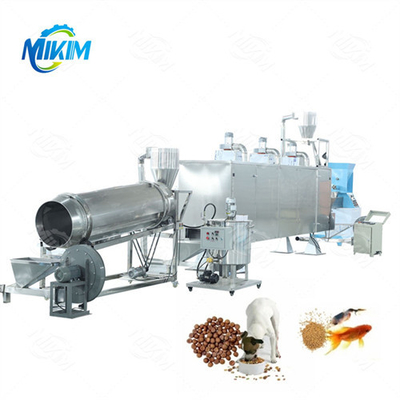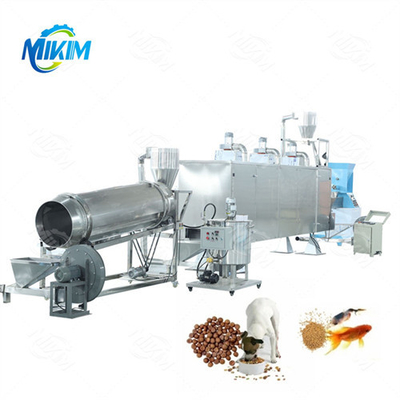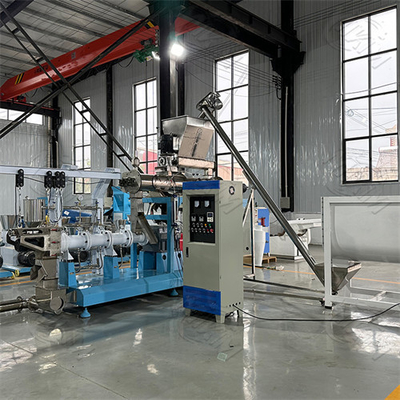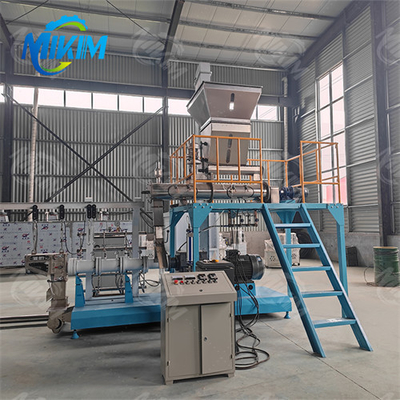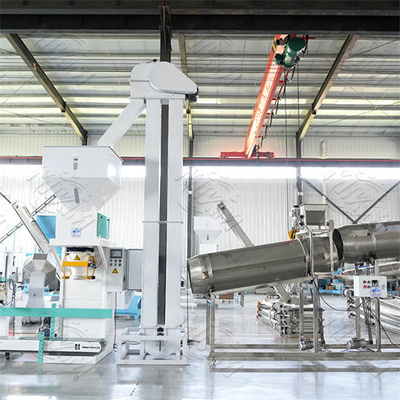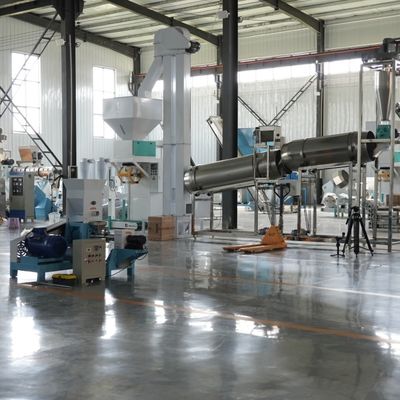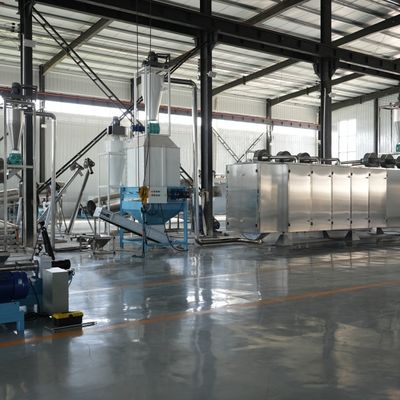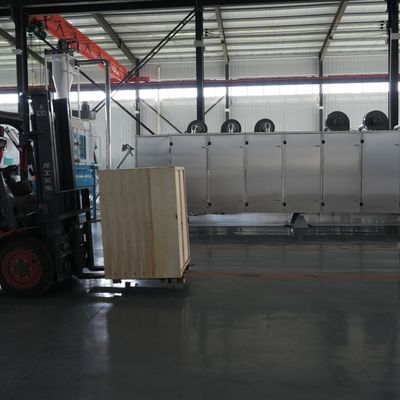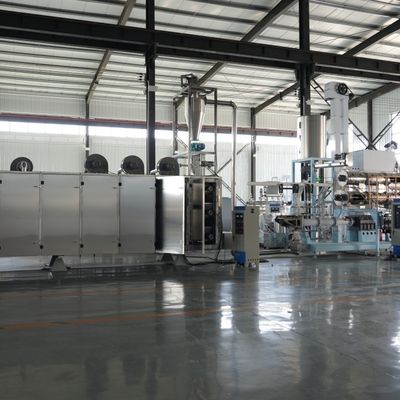5~10t/h 수산물 생선 사료 생산 라인
| 속성 |
가치 |
| 사용 |
떠다니는/몰아지는 생선 먹이 펠렛 제조 |
| 적용 |
생선 사료 생산 |
| 주요 판매점 |
높은 안전 수준 |
제품 설명
생선 사료 펠렛 공장에서의 제품 다양성을 고려하여 우리는 5~10t/h의 생선 사료 공장 솔루션을 제작하기 위해 연구개발 및 혁신을 강화했습니다.
이 생선 먹이 extrusion 생산 라인은 일반적으로 먹이 대량 생산에 사용됩니다. 그것은 좋은 자기 청소 효과와 함께 깔끔하고 균일하고 아름다운 초 작은 지름의 입자를 생산 할 수 있습니다.분리할 필요가 없습니다., 좋은 성숙도, 높은 수분 함량, 광범위한 응용 범위, 그리고 주로 수류 사료, 애완 동물 사료 및 동물 사료에 사용되는 고유 및 고 습도 물질을 생산 할 수 있습니다.
| 사양 |
세부 사항 |
| 전체 라인의 크기 |
토지 크기와 배열에 따라 |
| 펠릿 크기 |
1~12mm |
| 용량 |
5~10t/h |
| 근로자 요구 사항 |
4-5명 |
| 운송 요건 |
5*40ft 컨테이너 |
| 적용 범위 |
대형 상업용 수산물/동물 사료 공장 |
| 프로세스 흐름 |
- 배트 엘리베이터
- 원자재 청소 시스템
- 밀폐기용 실로
- 분쇄기
- 원자재 자동 분배 무게 시스템
- 혼합 시스템
- 두 번째 분쇄 시스템
- 원자재 자동 분배 무게 시스템
- 두 번째 혼합 시스템
- 엑스트루더
- 건조 시스템
- 화면 시스템
- 향신료 기계
- 냉각 시스템
- 포장 시스템
|
생산 라인의 각 부분에 대한 소개
배트 엘리베이터
버킷 엘리베이터 (Bucket elevator) 는 물체를 수직으로 들어올리기 위해 끝없는 견인 기기에 균등하게 고정된 버킷을 사용하는 연속 운송 기계입니다.
원자재 정화 시스템
청소 작업은 자석, 스크린, dust collectors and other equipment and systems to remove these impurities to ensure that the stored grain is of good quality and to protect the machinery during subsequent 5-10t/h fish feed pellet processing steps.
실로 시스템
지속적인 생산을 보장하기 위해, 옥수수, 밀 및 콩가루와 같은 많은 양의 원자재가 사료 가공 중에 저장되어야합니다.철강 실로의 원료는 좋은 품질이며 작동이 쉽습니다..
첫 분쇄
밀링은 사료의 입자 크기를 줄이고 특정 표면적을 증가시키는 작업으로 동물의 소화를 향상시키고 사료 활용도를 향상시킬 수 있습니다.그리고 또한 5-10t / h 생선 사료 공장의 처리 품질과 작업 효율을 향상, 혼합, 추출
첫 번째 조리 및 혼합
첫 번째 조리 과정은 무량 건조 원료와 액체 원료를 합쳐서 부가가치와 균등한 비율의 혼합물을 만드는 것을 의미합니다.첫 번째 혼합은 복합축료 생산에서 중요한 과정입니다.. It combines ingredients with unique properties into formulated rations under the action of subsequent processing equipment that meets all the nutritional needs of the animal and adds value to the blended commodity.
두 번째 분쇄 부문
추출된 수산물 사료의 생산 과정 요구 사항을 충족시키기 위해원료는 얇은 곡물 펠렛을 가공하여 펠렛의 내구성을 향상시키고 엑스트루딩/펠렛화 용량을 높이기 위해 얇은 곡물 펠렛의 요구 사항을 충족시키기 위해 얇게 또는 초미세하게 분쇄되어야 합니다..
두 번째 조리 및 혼합
두 번째 조리 과정은 8-10t/h의 생선 먹이 펠릿 공장에서 건조하고 액체 미세 요소와 프리믹스의 껍질, 추가 및 혼합을 통해 완전한 먹이 믹스를 형성합니다. 포뮬러 조리.2차 혼합은 혼합식품 생산의 핵심 요소입니다.외부 힘의 영향 하에, 독특한 특성을 가진 성분들은 동물의 영양 필요를 충족시키고 혼합된 제품의 가치를 높이기 위해 수제 식단으로 혼합됩니다.
추출 시스템
펌핑 (Puffing) 은 수분, 부풀 수 있는 스타크 또는 단백질 물질이 수분, 압력, 열과 5~10t/h의 생선 먹이 기계의 조합으로 튜브에 플라스틱화되는 과정이다.잠수식품 공정에서, 가공된 피드 펠렛은 펠렛 장비에 들어가 펠렛화 방에서 롤러와 폼을 통해 펠렛으로 압축됩니다.또한 떠있는 생선 먹이 extruder로 생선 먹이를 처리 할 수 있습니다..
검사 시스템
냉각 및 건조 후, 추출된 생선 사료 펠렛 전체는 세분화되어 미세한 물질과 유출물을 제거하고 펠렛을 수용 가능한 크기로 가져옵니다.
액체 투여 및 분사 시스템
스프레이는 5~10t/h의 생선 사료 펠렛 공장에서의 산업적 과정입니다. 펠렛이 건조되고 선별된 후, 펠렛이 냉각되기 전에, 기름/지방과 같은 액체나 분말을 적용합니다.색소, 맛, 기능 변형 물질 또는 비타민, 진압 된 펠릿의 표면에 펠릿의 맛과 수용성을 향상시키기 위해.
냉각 시스템
피드 진압 과정에서 피드 펠릿의 냉각은 필수적입니다. 쌍 나사 진압기를 떠날 때 진압 된 피드 펠릿은 매우 뜨겁고 부드럽고 습도가 풍부합니다.냉각 과정은 방온보다 약간 높은 3°C-5°C까지 냉각하고 안전 표준 (≤120,5%), 쉽게 운송 및 보관 할 수 있습니다.
포장 및 팔레티화 시스템
포장 작업 은 완성 된 사료 가 포장기 위 에 있는 공급 용기 에 들어가게 되면 시작 되며, 포고 된 사료 가 창고 에 들어서게 되면 끝난다.,무게를 가방에 넣고, 가방 입구를 닫고, 가방에 라벨을 붙이고, 가방에 코드를 붙이고, 가방에 팔레티를 넣고, 가방을 창고로 옮깁니다.
마감품인 사료 펠릿
우리 의 장비 의 장점
- 수입 고품질 베어링과 오일 밀폐는 안정적인 작동, 낮은 소음 및 전체 기계의 높은 효율을 보장하기 위해 사용됩니다.
- 다양한 오프터링 링 다이가 선택 가능하며 프로세스 링 다이는 긴 서비스 수명, 부드러운 펠릿 및 높은 품질을 가지고 있습니다.
- 국제 첨단 수준의 결합은 새로운 구조, 컴팩트성, 안전성, 낮은 소음 및 낮은 결함 성능을 가지고 있습니다.
- 생산 수식을 바꾸면 시장에서 인기있는 침몰 및 떠있는 생선 먹이를 생산 할 수 있습니다.
왜 우리 를 선택 합니까?
- 만약 고객들이 떠있는 생선 사료 외에도 새우 사료, 가축 및 가금류 사료, 애완 동물 사료, 프리믹스 및 다른 종류를 가공하고 싶다면우리는 고객의 제품 계획에 따라 전체 생산 라인 계획을 사용자 정의 할 수 있습니다;
- 전체 생산 라인은 모듈형 디자인을 채택하고 고객의 실제 필요, 공식, 공장 구조, 바닥 공간 및 기타 요구 사항에 따라 사용자 정의 할 수 있습니다.
- 물고기 먹이 장비와 전기 부품은 고객의 요구에 따라 구성 될 수 있으며, 모터와 전기 부품 브랜드도 고객의 요구에 따라 교체 될 수 있습니다.
- 우리는 또한 떠있는 생선 사료 생산에 대한 기술 전환 프로젝트를 수행 할 수 있습니다. 지속적인 장비 업그레이드, 최적화 및 서비스는 많은 이점을 가져다 줄 것입니다.
프로세스 설계, 장비 레이아웃, 공장 건설 계획, 단일 기계 장비 요금, 턴키 요금 등에 대한 자세한 내용은 저희에게 연락하십시오.
장비 사진
명예 증명서

 귀하의 메시지는 20-3,000 자 사이 여야합니다!
귀하의 메시지는 20-3,000 자 사이 여야합니다! 이메일을 확인하십시오!
이메일을 확인하십시오!  귀하의 메시지는 20-3,000 자 사이 여야합니다!
귀하의 메시지는 20-3,000 자 사이 여야합니다! 이메일을 확인하십시오!
이메일을 확인하십시오! 
